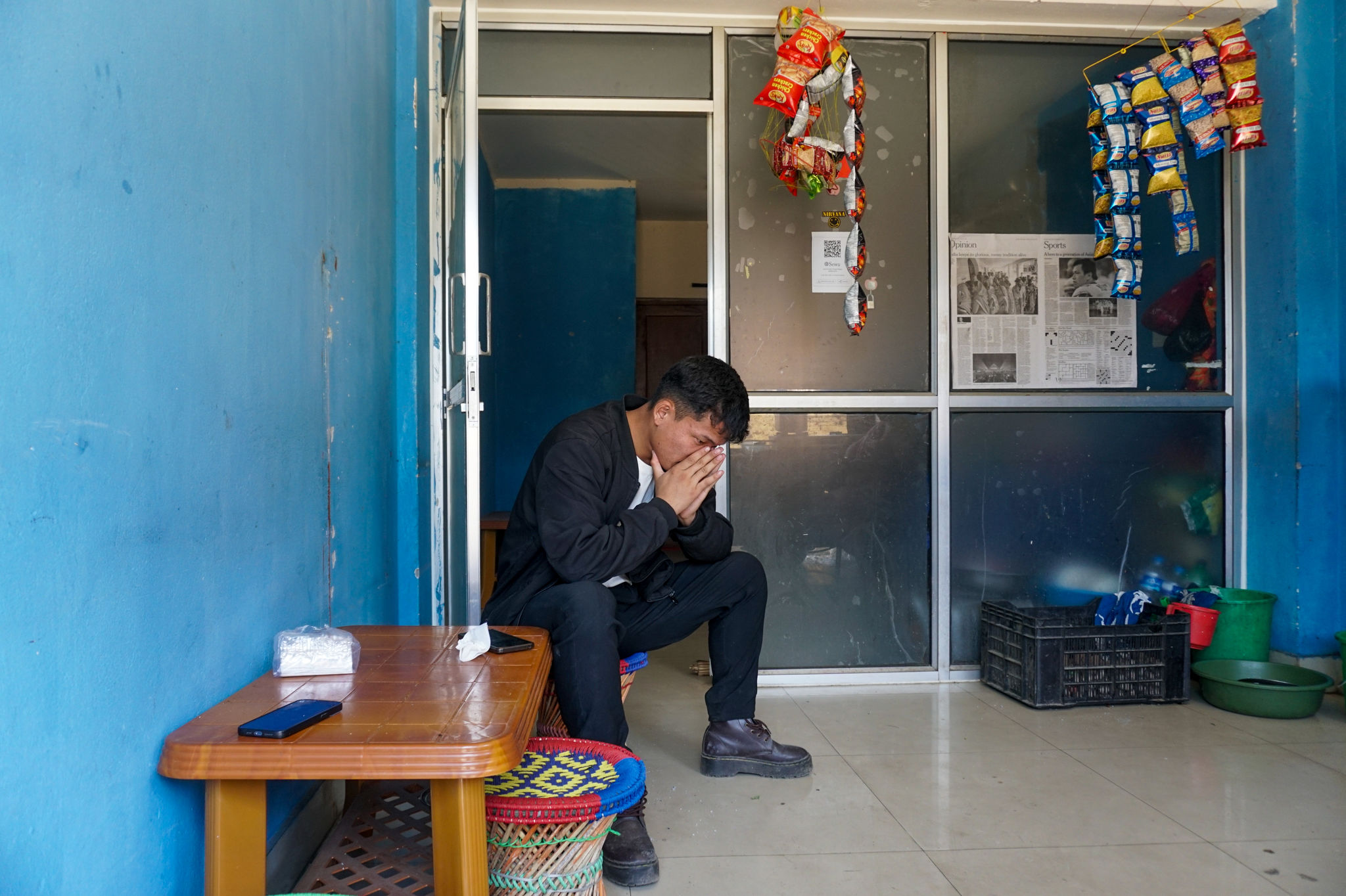Cyber Slavery: The New Face of Forced Labor in Southeast Asia

KATHMANDU, NEPAL — In 2024, Netra, a 21-year-old from a village in eastern Nepal, entered what he thought was a technology center in a remote area of Myanmar. Instead, what he found horrified him. The people inside had gouged eyes and amputated limbs. Others lay unconscious.
At the gate, he says, guards had stripped him of his passport and phone and shoved a contract in front of him. No drugs, it said. No phones. Human trafficking accepted.
Netra realized he wasn’t going to start a dream job. Instead, he’d been trafficked into a cyber slavery ring, where he would scam people around the world — or be tortured.
“The choice was to die or sign,” he says. “I signed to let myself be sold.”
Netra is among more than 220,000 people believed to have been trafficked into cybercrime hubs in remote areas of Myanmar and Cambodia. Under armed guards, they’re forced to perpetrate crypto and romance scams, fueling a hidden, multibillion-dollar global cyber slavery industry. Those trafficked into these cyber slavery rings tend to be young, have some English-language skills — and come from countries with few job opportunities.
In Bangladesh, Faysal, 26, accepted a high-paying job in Thailand from a trusted friend — or so he believed. Faysal had worked for years in Dubai as a graphics designer and briefly in a restaurant kitchen after he lost his job during the pandemic. But this new offer was perfect: more money and the promise of a better life. Plus, he says, recruiters told him that they’d bear the costs of visa processing and his flight. But when he arrived, he was tortured and forced to work under inhumane conditions.

The same was true for Jenny, in the Philippines. In 2022, she says, a relative told her about a job as an encoder in Thailand. At the time, she was working as a security guard in a city southwest of Manila. The new job offered a salary four times higher. She sent a video application on Messenger, and within three days, she was on a plane to Thailand.
There, she was forced to impersonate a Korean model, “Miranda,” chatting with over 50 people daily to scam them out of money. Her experience was horrific, she says, and marked by physical abuse.
In many Asian countries, remittances make up a large percentage of the gross domestic product (5% in Bangladesh, 9% in the Philippines and 25% in Nepal). Citizens often move abroad to pursue low- or semi-skilled work in the construction industry, or as drivers or domestic help. The opportunity to work in an office in the technology sector can seem too good to be true.
Som Luitel, from Nepal’s People’s Forum for Human Rights, says the scams rely on people’s “desperation to go abroad.”
 Geela Garcia, GPJ Philippines
Geela Garcia, GPJ Philippines
A modern industry
Cyber slavery is a relatively new phenomenon. Stories from people who were rescued or escaped reveal accounts of physical abuse, inhumane work conditions, entrapment and other human rights violations.
Asia, long a hub for call-center scams, is the global engine of these crimes, a source of both revenue and labor, according to a United Nations report published in April. As Asia’s digital transformation accelerated after the coronavirus pandemic, so did the scams. Just this February, an armed group in Myanmar rescued 260 people from 19 countries who were trapped in industrial-scale scam centers.
“Transnational organized crime, particularly in Southeast Asia, is evolving at a rate the region has never seen before,” says Rebecca Miller, a regional coordinator on Asian human trafficking at the UN Office on Drugs and Crime. The growth, she says, is fueled by new service-based models and the ability to move profits and value across borders with “unmatched speed and efficiency.”
The compounds where trafficked people are forced to work have mushroomed across Asia since the pandemic, transforming Chinese and Cambodian casino areas of the 1990s into cyber slavery hubs.
A 2024 report by the United States Institute of Peace estimates that cyberscams bring in US$12.5 billion in Cambodia, US$15.3 billion in Myanmar and US$10.9 billion in Laos — nearly 40% of their combined GDP.
Now, cyber slavery compounds are even cropping up in new countries. In the Philippines, the government has raided and taken over multiple compounds where cyber slavery and other forms of human trafficking and abuse occurred. Those compounds are now used as detention facilities for the people who ran them as labor trafficking centers.

 Geela Garcia, GPJ Philippines
Geela Garcia, GPJ Philippines
This isn’t just a regional crisis: In 2023, US residents lost US$12 billion to cyber scams, much of it linked to Southeast Asian syndicates.
People in low-income countries like Nepal, Bangladesh and the Philippines are at the greatest risk of being trafficked into cyber slavery centers. Poverty is widespread, and well-paying jobs are hard to find.
Recruiters look for young people who are digitally literate and familiar with basic tech, says Gyan Bahadur Bista, deputy superintendent of police at the Nepal government’s Anti Human Trafficking Bureau. Scam centers are growing more multilingual, so people with English skills remain prime targets, he says.
While a few of the young people are abducted, most are lured voluntarily by job ads on Facebook, Instagram or messaging apps like WhatsApp and Telegram. The ads promise salaries of US$1,000–US$1,500 for vague roles, like translators or customer service agents. Fake logos and staged interviews contribute to the illusion of legitimacy.
The cyber slavery rings scam workers in many of the same ways they expect their workers to later rake in money from people around the world. Deepfakes, blockchain generative AI and machine learning help them “execute social engineering scams with alarming success rates, exploiting people’s trust and emotions,” according to a January 2024 UN report.
The trap is often well disguised. Prospective workers usually travel on tourist visas arranged by local agents, so their departures raise no red flags. Immigration authorities only occasionally intervene, as agents prepare legitimate paperwork and hotel bookings.
“Syndicates make it easy, telling victims that they don’t have to spend anything … and victims grab it without verifying anything,” says Bernard Olalia, undersecretary at the Philippines’ Department of Migrant Workers.
With their papers in order, hopeful young workers pass through borders unnoticed.
Suspicion among family members and friends usually only arises when those who leave never return. Last year, the Indian government announced that between January 2022 and May 2024, nearly 30,000 Indians went to Cambodia, Thailand, Myanmar and Vietnam on visitor visas and didn’t come back.
Corrupt officials, remote regions
The scam centers are mostly based in Myanmar’s ungoverned territories, but they rely on bordering Thailand’s infrastructure — power, telecom and finance — to operate. The Moei River corridor, the natural border between Thailand and Myanmar, hosts at least 17 crime zones spanning 5 million square meters, according to the US Institute of Peace. These zones flourished after Myanmar’s 2021 military coup.
The compounds resemble militarized business parks, constantly patrolled by soldiers but complete with dorms, basketball courts, clinics, and salons and shops offering alcohol and sex workers.
These criminal networks have strategically placed themselves in border areas far from capital cities, places where the rule of law is weak or corruptible, and in some cases, under armed group control, says Miller of the UN Office on Drugs and Crime.
“This is posing a distinct challenge for the governments of the region,” Miller says. “How do you confront something that is in a place you don’t control?”
These organizations use legitimate-appearing fronts and virtual assets to mask activities from gambling to human trafficking. Corruption is rife. Administrative entities in Thailand, Myanmar and China as well as trafficking networks from Bangladesh and Dubai are all involved, says Rayhan Kabir, a sector specialist at the BRAC Migration Program.
“Every link in this chain participates in the trafficking process,” he says. “It’s global organized crime.”
He says police move trafficked people past immigration then transfer them to hotels along the border. Then they’re ferried across the river, where armed groups seize them.
“In many places, police are corrupt,” Olalia says. “Even the government officials themselves are part of the syndicate.”

‘It all happened so fast’
Netra had no tech experience, but when his uncle’s friend offered him a job as a computer technician in Thailand for US$1,600 a month — nearly 12 times the average salary in Nepal — he jumped at the chance.
“It all happened so fast,” Netra says. “I barely had time to think.”
Netra isn’t his real name. It’s the identity he used in Myanmar. He worked 18-hour shifts impersonating “Alicia,” a fake businesswoman used to bait people into investment scams. He followed scripts to build emotional trust, only to vanish after people wired about US$265.
The trapped scammers follow a detailed manual to “pig-butcher” their targets —fatting them up before cleaning them out.
Once Jenny made it to the Thailand-Myanmar border, she “was made to jump off from a window [of a building] to ride a tire across the river.” She worked against her will in a scam center for almost a year.
Faysal landed in Thailand thinking he’d secured a tech job. Instead, armed men met him at the airport, drove him for hours, and forced him at gunpoint into Myanmar.
He was tortured when he was unable to reach his scam targets. Once, they used an electric shock tool on his genitals.
“They had beaten one person to death,” he says. “I heard that one woman committed suicide there.”
 Fabeha Monir, GPJ Bangladesh
Fabeha Monir, GPJ Bangladesh
Escape is rare
Once inside these compounds, escape requires luck, outside help or both.
The internet’s borderless nature complicates jurisdiction, enabling criminals to operate from one country while pursuing targets in another. Crimes like soliciting crypto ransom payments often fall outside traditional legal frameworks.
In the 18 months prior to April, Nepal’s Human Trafficking Investigation Bureau has recorded 16 digital slavery cases and arrested 25 people, including three Chinese nationals. Still, prosecution remains difficult because of jurisdictional challenges.
“Scams like phishing and romance frauds often use foreign servers, making it hard for Nepali authorities to collect digital evidence,” says Bista, the deputy superintendent of police.
Other countries face similar challenges.
“We can use all our power to take immediate action when it happens inside Bangladesh, but when it’s an international crime or multinational parties are involved, we have to go through an appropriate channel, which takes time and makes things very challenging,” says Bangladesh CID additional superintendent of police Mostafizur Rahman.
 Geela Garcia, GPJ Philippines
Geela Garcia, GPJ Philippines
It’s particularly difficult to find anyone guilty because, unlike other forms of trafficking, these workers technically consent to the jobs.
“Sometimes, when the overseas Filipino workers are caught, they are treated as violators, questioned on how they arrived in these countries in the first place,” Olalia says.
Netra says men from the Democratic Karen Buddhist Army demanded US$8,000 for his release, but he eventually escaped with help from a Burmese man of Nepali origin, someone known among captives for helping many flee the scam centers. “After four months,” he says, “I saw the light of day and cried with joy.”
Faysal helped plan a mass escape. He was recaptured but eventually freed during a joint Thailand-Myanmar military operation. They rescued 92 people.
Faysal says he can’t sit still due to ligament injuries from his escape.
Jenny was released after six months and now works with the Presidential Anti-Organized Crime Commission to help others like her.
“For the first year, I couldn’t talk about what happened without crying,” she says. “But I chose to speak out, so others won’t fall into the same trap.”
Sunita Neupane/Fabeha Monir/Geela Garcia/ Global Press Journal



















